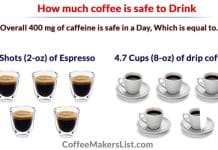Imagine waking up on a warm summer morning, greeted by the enticing aroma of freshly brewed coffee. Now, picture that coffee being smooth, refreshing, and with a wonderfully low acidity. Sounds like a dream, right? Well, dream no more because cold brew coffee is here to revolutionize your morning routine. In this article, we’ll take you on a journey into the world of cold brew coffee, where we’ll explore the secrets behind its smooth, low acidity profile. Get ready to discover a whole new way to enjoy your favorite beverage.
What is Cold Brew Coffee?
Definition
Cold brew coffee is a method of preparing coffee that involves steeping coarse-ground coffee beans in cold or room temperature water for an extended period of time. Unlike traditional methods of brewing coffee that use hot water, cold brew is made using cold water. This results in a coffee that is smooth, less acidic, and has a unique flavor profile.
Process
The process of making cold brew coffee is simple but requires patience. It begins by coarsely grinding coffee beans, which helps to extract the flavors without over-extraction. The ground coffee is then combined with cold water in a container and left to steep for an extended period of time, usually around 12 to 24 hours. After the steeping time is complete, the coffee needs to be filtered to separate the liquid from the grounds. This can be done using a fine mesh strainer, a cold brew coffee maker, or even a French press. The resulting cold brew concentrate can be diluted with water or served over ice to create a refreshing cold coffee beverage.
Benefits of Cold Brew Coffee
Reduced Acidity
One of the main benefits of cold brew coffee is its reduced acidity compared to traditional hot brewed coffee. The cold water extraction process results in a coffee that is less acidic and smoother on the stomach. This makes it a great option for those who experience stomach sensitivities or acid reflux when drinking hot coffee. The lower acidity also allows for the flavors of the coffee to shine through, giving a more well-rounded taste experience.
Smooth Flavor
Cold brew coffee has a distinct flavor profile that sets it apart from hot brewed coffee. The slow and gentle extraction process of cold brewing results in a coffee that is smooth, mellow, and less bitter. The flavors are often described as rich, chocolaty, and slightly sweet. The lack of heat in the brewing process also preserves the delicate aromas and oils of the beans, resulting in a cup of coffee with a more complex flavor profile.
No Heat Required
Another benefit of cold brew coffee is that it does not require any heat during the brewing process. This means that it can be made and enjoyed all year round, without adding extra heat to your kitchen in warmer months. The absence of heat also eliminates the risk of over-extraction or burning the coffee, ensuring a consistently delicious cup of cold brew every time.
Difference Between Cold Brew and Iced Coffee
Brewing Method
While both cold brew and iced coffee are enjoyed cold, they are prepared using different brewing methods. Cold brew coffee is made by steeping coffee grounds in cold water for an extended period of time, as mentioned earlier. On the other hand, iced coffee is made by brewing hot coffee using traditional methods and then cooling it down with ice.
Flavor Profile
The brewing method used in cold brew coffee results in a distinct flavor profile that can differ from that of iced coffee. Cold brew coffee tends to be smoother, less acidic, and slightly sweeter in flavor compared to iced coffee. Iced coffee, on the other hand, retains more of the traditional coffee flavor with its characteristic acidity. The choice between cold brew and iced coffee ultimately comes down to personal preference and the desired flavor experience.
Choosing the Right Coffee Beans
Roast Level
The choice of coffee beans plays a significant role in determining the flavors and characteristics of your cold brew coffee. When selecting beans, consider the roast level that best suits your taste preferences. Darker roasts tend to produce bolder and more robust flavors, while lighter roasts offer brighter and more nuanced flavors. Experiment with different roast levels to find the flavor profile that you enjoy the most in your cold brew.
Origin
The origin of the coffee beans also influences the flavor of your cold brew coffee. Different regions and countries produce coffee with distinct flavor profiles and aromas. For example, beans from Central America may have a bright and citrusy flavor, while beans from South America are known for their chocolate and nutty notes. Consider exploring beans from various origins to discover the flavors that excite your taste buds.
Grind Size
Grinding the coffee beans to the appropriate size is crucial for a successful cold brew extraction. For cold brew, a coarse grind is recommended to ensure proper extraction and to prevent over-extraction. A coarse grind allows water to flow freely through the coffee grounds, resulting in a smoother and less bitter cup of cold brew. Invest in a quality burr grinder to ensure consistent grind size and optimal flavor extraction.
Cold Water vs. Ice Water
Temperature Effects
The temperature of the water used to make cold brew can impact the extraction process and the resulting flavor of the coffee. While both cold water and ice water can be used to make cold brew, using cold water is the more common approach. Cold water provides a slower and more controlled extraction, resulting in a smoother and less bitter cold brew. Ice water, on the other hand, can lead to quicker and potentially over-extracted coffee.
Steeping Time
The temperature of the water used for cold brew also affects the recommended steeping time. When using cold water, a longer steeping time of around 12 to 24 hours is typically recommended to extract the flavors fully. If using ice water, a shorter steeping time of 8 to 12 hours may be sufficient due to the quicker extraction process. Experiment with different steeping times to find the perfect balance of flavors for your cold brew.
Equipment Needed for Cold Brew
Mason Jars
Mason jars are a versatile and affordable option for making cold brew coffee. They can be easily found in most supermarkets or kitchen supply stores. To make cold brew in a mason jar, simply combine the coffee grounds and cold water in the jar, and then cover it tightly. After steeping, use a fine mesh strainer to separate the liquid from the grounds.
Cold Brew Coffee Maker
If you plan on making cold brew regularly, investing in a cold brew coffee maker can simplify the process. Cold brew coffee makers are designed specifically for cold brewing, with built-in filters and mechanisms for easy extraction and storage. They come in a variety of sizes and styles, allowing you to brew large batches or single servings of cold brew coffee.
French Press
A French press is a popular and widely available option for making cold brew coffee. Its built-in plunger and mesh filter make it easy to separate the grounds from the liquid after steeping. Simply combine the coffee grounds and cold water in the French press, let it steep, and then press down the plunger to separate the coffee from the grounds.
Fine Mesh Strainer
If you don’t have any specialized equipment for cold brewing, a fine mesh strainer can do the job just fine. After steeping the coffee grounds in cold water, simply pour the mixture through the strainer into another container to separate the liquid from the grounds. This method may require more care and attention to ensure that all of the grounds are properly filtered.
Steps to Make Cold Brew Coffee
Grinding the Coffee
Start by grinding your coffee beans to a coarse consistency. This ensures proper extraction and prevents over-extraction. If you don’t have a grinder, look for pre-ground coffee labeled specifically for cold brew, as the grind size may differ from regular coffee.
Proportions
The general guideline for cold brew coffee is to use a ratio of 1 part coffee grounds to 4 parts water. However, you can adjust this ratio to suit your personal taste preferences. If you prefer a stronger brew, use more coffee grounds. If you prefer a milder brew, use less coffee grounds.
Steeping Time
After combining the coffee grounds and cold water in your chosen brewing vessel, let the mixture steep for around 12 to 24 hours. This longer steeping time allows for the flavors to fully develop and extract into the coffee.
Filtering the Brew
Once the steeping time is complete, it’s time to filter the cold brew. Use a fine mesh strainer, cold brew coffee maker, or French press to separate the liquid from the grounds. Be patient during this process to ensure that all of the grounds are properly filtered. Once filtered, your cold brew coffee is ready to be enjoyed as is or diluted with water.
Tips for a Perfect Cold Brew
Experiment with Ratios
Don’t be afraid to experiment with different ratios of coffee grounds to water when making cold brew coffee. Adjusting the ratio allows you to customize the strength and intensity of the flavor to suit your taste preferences. Start with the general guideline of 1 part coffee to 4 parts water and then make adjustments from there.
Use Filtered Water
Using filtered water can significantly impact the taste and clarity of your cold brew coffee. Impurities in tap water can alter the flavor and leave behind unwanted residues. Filtered water helps to ensure a clean and pure taste in your cold brew.
Store Properly
When storing your cold brew coffee, it’s important to do so in airtight containers in the refrigerator. This helps to preserve the flavors and prevent oxidation. Cold brew coffee can typically be stored for up to a week, but it’s best to consume it within a few days for the freshest taste.
Flavoring and Serving Cold Brew Coffee
Adding Sweeteners or Milk
Cold brew coffee can be enjoyed on its own, but if you prefer to add sweeteners or milk, feel free to experiment. Cold brew pairs well with various sweeteners such as honey, sugar, or simple syrup. Milk or cream can also be added to create a creamy and smooth iced coffee experience. Customize your cold brew to your liking and enjoy the endless possibilities.
Cold Brew Concentrate
If you prefer a stronger and bolder cold brew, you can create a concentrate by using a higher coffee-to-water ratio during the brewing process. This concentrate can be stored in the refrigerator and then diluted with water or milk when it’s time to enjoy a cup of cold brew. The concentrate allows for flexibility in flavor intensity and makes it convenient to prepare individual servings when desired.
Serving Suggestions
Cold brew coffee can be enjoyed over ice, or you can get creative with serving suggestions. Add a splash of vanilla extract or a sprinkle of cinnamon to enhance the flavors. Create coffee ice cubes using cold brew coffee to prevent dilution when served over ice. The versatility of cold brew allows for endless possibilities to elevate your coffee-drinking experience.
Cold Brew vs. Traditional Brewing
Time
One significant difference between cold brew and traditional brewing methods is the time it takes to prepare the coffee. Traditional brewing methods, such as using a coffee maker or pour-over method, usually require several minutes to brew hot water and extract the coffee flavors. Cold brew, on the other hand, requires a longer steeping time of around 12 to 24 hours. While this longer wait time is necessary for cold brew, it allows for a unique and smooth flavor profile.
Caffeine Content
The caffeine content in cold brew coffee can be higher compared to traditional brewing methods. Although cold brew is made using cold water, the longer steeping time allows for a fuller extraction of the caffeine. However, it’s essential to note that the concentration of caffeine can vary depending on the coffee beans used and the brewing technique.
Taste Comparison
When comparing the taste of cold brew and traditionally brewed coffee, the differences are quite noticeable. Cold brew coffee typically has a smoother and less acidic taste, allowing for the flavors of the coffee beans to shine through. Traditional brewing methods often result in a bolder and more acidic flavor, which can be appreciated by coffee lovers who enjoy a strong and robust cup of coffee. Ultimately, the choice between cold brew and traditional brewing methods comes down to personal preference and the desired taste experience.
In conclusion, cold brew coffee offers a unique and flavorful alternative to traditional hot brewed coffee. With its reduced acidity, smooth flavor, and no heat required brewing process, cold brew has gained popularity amongst coffee enthusiasts. By choosing the right coffee beans, understanding the difference between cold brew and iced coffee, mastering the brewing process, and experimenting with flavorings and serving options, you can elevate your cold brew coffee experience. Whether enjoying it over ice on a hot summer day or savoring a cup of concentrated cold brew in the morning, cold brew coffee provides a refreshing and delicious way to satisfy your coffee cravings. So grab your favorite coffee beans, some cold water, and start brewing your own batch of smooth, low acidity cold steeped cold brew coffee today!







































